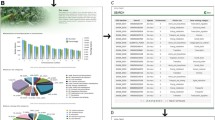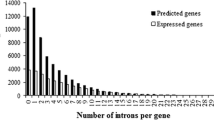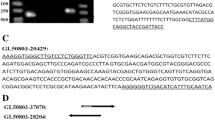Abstract
The present century has witnessed an unprecedented rise in genome sequences owing to various genome-sequencing programs. However, the same has not been replicated with cDNA or expressed sequence tags (ESTs). Hence, prediction of protein coding sequence of genes from this enormous collection of genomic sequences presents a significant challenge. While robust high throughput methods of cloning and expression could be used to meet protein requirements, lack of intron information creates a bottleneck. Computational programs designed for recognizing intron–exon boundaries for a particular organism or group of organisms have their own limitations. Keeping this in view, we describe here a method for construction of intron-less gene from genomic DNA in the absence of cDNA/EST information and organism-specific gene prediction program. The method outlined is a sequential application of bioinformatics to predict correct intron–exon boundaries and splicing by overlap extension PCR for spliced gene synthesis. The gene construct so obtained can then be cloned for protein expression. The method is simple and can be used for any eukaryotic gene expression.




Similar content being viewed by others
References
Solovyev, V., Kosarev, P., Seledsov, I., & Vorobyev, D. (2006). Automatic annotation of eukaryotic genes, pseudogenes and promoters. Genome Biology, 7(Suppl 1), S10.1–S12.
Brent, M. R., & Guigo, R. (2004). Recent advances in gene structure prediction. Current Opinion in Structural Biology, 14, 264–272. doi:10.1016/j.sbi.2004.05.007.
Makarov, M. (2002). Computer programs for eukaryotic gene prediction. Briefings in Bioinformatics, 3, 195–199. doi:10.1093/bib/3.2.195.
Rogic, S., Ouellette, B. F., & Mackworth, A. K. (2002). Improving gene recognition accuracy by combining predictions from two gene-finding programs. Bioinformatics (Oxford, England), 18, 1034–1045. doi:10.1093/bioinformatics/18.8.1034.
Vats, P., Sahoo, D. K., & Banerjee, U. C. (2004). Production of phytase (myo-inositolhexakisphosphate phosphohydrolase) by Aspergillus niger van Teighem in laboratory-scale fermenter. Biotechnology Progress, 20, 737–743. doi:10.1021/bp034095v.
Howson, S. J., & Davis, R. P. (1983). Production of phytate-hydrolysing enzyme by some fungi. Enzyme and Microbial Technology, 5, 377–382. doi:10.1016/0141-0229(83)90012-1.
Mullaney, E. J., Daly, C. B., & Ullah, A. H. (2000). Advances in phytase research. Advances in Applied Microbiology, 47, 157–199. doi:10.1016/S0065-2164(00)47004-8.
Wodzinski, R. J., & Ullah, A. H. (1996). Phytase. Advances in Applied Microbiology, 42, 263–302. doi:10.1016/S0065-2164(08)70375-7.
Lei, X. G., & Porres, J. M. (2003). Phytase enzymology, applications, and biotechnology. Biotechnology Letters, 25, 1787–1794. doi:10.1023/A:1026224101580.
Ullah, A. H. (1988). Production, rapid purification and catalytic characterization of extracellular phytase from Aspergillus ficuum. Preparative Biochemistry, 18, 443–458. doi:10.1080/00327488808062543.
Kostrewa, D., Wyss, M., D’Arcy, A., & van Loon, A. P. (1999). Crystal structure of Aspergillus niger pH 25 acid phosphatase at 2 4 A resolution. Journal of Molecular Biology, 288, 965–974. doi:10.1006/jmbi.1999.2736.
Li, X. L., & Ljungdahl, L. G. (1996). Expression of Aureobasidium pullulans xynA in, and secretion of the xylanase from, Saccharomyces cerevisiae. Applied and Environmental Microbiology, 62, 209–213.
Horton, R. M., Hunt, H. D., Ho, S. N., Pullen, J. K., & Pease, L. R. (1989). Engineering hybrid genes without the use of restriction enzymes: Gene splicing by overlap extension. Gene, 77, 61–68. doi:10.1016/0378-1119(89)90359-4.
Warrens, A. N., Jones, M. D., & Lechler, R. I. (1997). Splicing by overlap extension by PCR using asymmetric amplification: An improved technique for the generation of hybrid proteins of immunological interest. Gene, 186, 29–35. doi:10.1016/S0378-1119(96)00674-9.
Burset, M., & Guigo, R. (1996). Evaluation of gene structure prediction programs. Genomics, 34, 353–367. doi:10.1006/geno.1996.0298.
Ho, S. N., Hunt, H. D., Horton, R. M., Pullen, J. K., & Pease, L. R. (1989). Site-directed mutagenesis by overlap extension using the polymerase chain reaction. Gene, 77, 51–59. doi:10.1016/0378-1119(89)90358-2.
Kuwayama, H., Obara, S., Morio, T., Katoh, M., Urushihara, H., & Tanaka, Y. (2002). PCR-mediated generation of a gene disruption construct without the use of DNA ligase and plasmid vectors. Nucleic Acids Research, 30, E2. doi:10.1093/nar/30.2.e2.
Shevchuk, N. A., Bryksin, A. V., Nusinovich, Y. A., Cabello, F. C., Sutherland, M., & Ladisch, S. (2004). Construction of long DNA molecules using long PCR-based fusion of several fragments simultaneously. Nucleic Acids Research, 32, e19. doi:10.1093/nar/gnh014.
Xiong, A. S., Yao, Q. H., Peng, R. H., Li, X., Fan, H. Q., Cheng, Z. M., et al. (2004). A simple, rapid, high-fidelity and cost-effective PCR-based two-step DNA synthesis method for long gene sequences. Nucleic Acids Research, 32, e98. doi:10.1093/nar/gnh094.
Yolov, A. A., & Shabarova, Z. A. (1990). Constructing DNA by polymerase recombination. Nucleic Acids Research, 18, 3983–3986. doi:10.1093/nar/18.13.3983.
Yon, J., & Fried, M. (1989). Precise gene fusion by PCR. Nucleic Acids Research, 17, 4895. doi:10.1093/nar/17.12.4895.
Heinonen, J. K., & Lahti, R. J. (1981). A new and convenient colorimetric determination of inorganic orthophosphate and its application to the assay of inorganic pyrophosphatase. Analytical Biochemistry, 113, 313–317. doi:10.1016/0003-2697(81)90082-8.
Laemmli, U. K. (1970). Cleavage of structural proteins during the assembly of the head of bacteriophage T4. Nature, 227, 680–685. doi:10.1038/227680a0.
Mortz, E., Krogh, T. N., Vorum, H., & Gorg, A. (2001). Improved silver staining protocols for high sensitivity protein identification using matrix-assisted laser desorption/ionization-time of flight analysis. Proteomics, 1, 1359–1363. doi:10.1002/1615-9861(200111)1:11<1359::AID-PROT1359>3.0.CO;2-Q.
Hellman, U., Wernstedt, C., Gonez, J., & Heldin, C. H. (1995). Improvement of an “In-Gel” digestion procedure for the micropreparation of internal protein fragments for amino acid sequencing. Analytical Biochemistry, 224, 451–455. doi:10.1006/abio.1995.1070.
Rosenfeld, J., Capdevielle, J., Guillemot, J. C., & Ferrara, P. (1992). In-gel digestion of proteins for internal sequence analysis after one- or two-dimensional gel electrophoresis. Analytical Biochemistry, 203, 173–179. doi:10.1016/0003-2697(92)90061-B.
Shevchenko, A., Wilm, M., Vorm, O., & Mann, M. (1996). Mass spectrometric sequencing of proteins silver-stained polyacrylamide gels. Analytical Chemistry, 68, 850–858. doi:10.1021/ac950914 h.
Mount, D. W. (2005). Bioinformatics sequence and genome analysis. New York: Cold Spring Harbor Laboratory Press.
Allen, J. E., Pertea, M., & Salzberg, S. L. (2004). Computational gene prediction using multiple sources of evidence. Genome Research, 14, 142–148. doi:10.1101/gr.1562804.
Murakami, K., & Takagi, T. (1998). Gene recognition by combination of several gene-finding programs. Bioinformatics (Oxford, England), 14, 665–675. doi:10.1093/bioinformatics/14.8.665.
Pavlovic, V., Garg, A., & Kasif, S. (2002). A Bayesian framework for combining gene predictions. Bioinformatics (Oxford, England), 18, 19–27. doi:10.1093/bioinformatics/18.1.19.
Baker, S. E. (2006). Aspergillus niger genomics: Past, present and into the future. Medical Mycology, 44(Suppl 1), S17–S21. doi:10.1080/13693780600921037.
Semova, N., Storms, R., John, T., Gaudet, P., Ulycznyj, P., Min, X. J., et al. (2006). Generation, annotation, and analysis of an extensive Aspergillus niger EST collection. BMC Microbiology, 6, 7. doi:10.1186/1471-2180-6-7.
Wilihoeft, U., Campos-Gongora, E., Touzni, S., Bruchhaus, I., & Tannich, E. (2001). Introns of Entamoeba histolytica and Entamoeba dispar. Protist, 152, 149–156. doi:10.1078/1434-4610-00053.
Acknowledgement
V.A. is a recipient of Senior Research Fellowship from Council of Scientific and Industrial Research (CSIR) New Delhi, India.
Author information
Authors and Affiliations
Corresponding author
Rights and permissions
About this article
Cite this article
Agrawal, V., Gupta, B., Banerjee, U.C. et al. A Method for Construction, Cloning and Expression of Intron-Less Gene from Unannotated Genomic DNA. Mol Biotechnol 40, 217–223 (2008). https://doi.org/10.1007/s12033-008-9076-1
Received:
Accepted:
Published:
Issue Date:
DOI: https://doi.org/10.1007/s12033-008-9076-1




